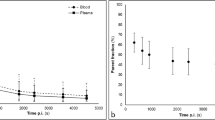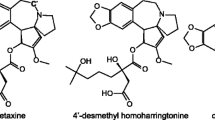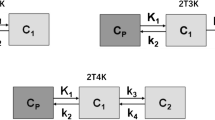Abstract
Purpose
This study aimed to evaluate the utility of plasma pharmacokinetic analyses of anti-cancer agents from data obtained during positron emission tomography (PET) oncology studies of radiolabelled anti-cancer agents.
Patients and methods
Thirteen patients were administered fluorine-18 radiolabelled 5-FU ([18F]5-FU) admixed with 5-FU, corresponding to a total 5-FU dose of 380–407 mg/m2 (eight patients) and 1 mg/m2 (five patients). Nine patients received 2.2–19.2 μg/m2 of carbon-11 radiolabelled N-[2-(dimethylamino)ethyl]acridine-4-carboxamide ([11C]DACA) at 1/1,000th of phase I dose, as part of phase 0 microdosing study. Radioactivity of parent drug obtained from arterial blood samples, the injected activity of the radiolabelled drug, and the total dose of injected drug were used to obtain plasma drug concentrations. Plasma pharmacokinetic parameters were estimated using model-dependent and model-independent methods.
Results
5-FU plasma concentrations at therapeutic doses were above the Km and a single compartment kinetic model was best used to fit the kinetics, with a mean half-life of 8.6 min. Clearance and volumes of distribution (V d) obtained using both model-dependent and model-independent methods were similar. Mean (SE) clearance was 1,421(144), ml min−1 and 1,319 (119) ml min−1 and the mean (SE) V d was 17.3 (1.8) l and 16.3 (1.9) l by the model-independent method and model-dependent methods, respectively. In contrast, with 1 mg/m2, plasma concentrations of 5-FU were less than the Km and a two-compartment model was used to best fit the kinetics, with the mean 5-FU half-life of 6.5 min. The mean (SE) clearances obtained by the model-independent method and model-dependent methods were 3,089 (314) ml min−1 and 2,225 (200) ml min−1, respectively and the mean (SE) V d were 27.9 (7.0) l and 2.3 (0.4) l, by the model independent and dependent methods, respectively. Extrapolation of AUC0–Clast to AUC0–∞ was less than 3% in both these cohort of patients. A two-compartment model with a mean half-life of 42.1 min was used to best fit the kinetics of DACA; considerable extrapolation (mean 26%) was required to obtain AUC0–∞ from AUC0–Clast. Mean (SE) clearance of DACA was 1,920 (269) ml min−1, with the model-independent method and 1,627 (287) ml min−1 with the model-dependent method. Similarly, V d [mean (SE)] of DACA with the model-independent and model-dependent methods were 118 (22) l and 50 (15) l, respectively.
Conclusions
Pharmacokinetic parameters can be estimated with confidence from PET studies for agents given at therapeutic doses, whose half-lives are significantly less than the total sampling time during the scan. Tracer studies performed alone, wherein plasma levels below the Km are expected, may also provide valuable information on drug clearance for the entire range of linear kinetics. However, drugs with half-lives longer than the sampling duration are inappropriate for PET plasma pharmacokinetic evaluation.


Similar content being viewed by others
References
Stoller RG et al (1977) Use of plasma pharmacokinetics to predict and prevent methotrexate toxicity. N Engl J Med 297(12):630–634
Calvert AH et al (1989) Carboplatin dosage: prospective evaluation of a simple formula based on renal function. J Clin Oncol 7(11):1748–1756
Wolf W, Waluch V, Presant CA (1998) Non-invasive 19F-NMRS of 5-fluorouracil in pharmacokinetics and pharmacodynamic studies. NMR Biomed 11(7):380–387
Saleem A, Aboagye EO, Price PM (2000) In vivo monitoring of drugs using radiotracer techniques. Adv Drug Deliv Rev 41(1):21–39
Bergstrom M, Grahnen A, Langstrom B (2003) Positron emission tomography microdosing: a new concept with application in tracer and early clinical drug development. Eur J Clin Pharmacol 59(5, 6):357–366
Saleem A et al (2001) Pharmacokinetic evaluation of N-[2-(dimethylamino)ethyl]acridine-4-carboxamide in patients by positron emission tomography. J Clin Oncol 19(5):1421–1429
Brown GD (1999) Radiolabelling of anticancer drugs with short-lived positron emitters for PET studies. University of London, London, p 256
Brown GD et al (1993) A practical synthesis of 5-[18F]Fluorouracil using HPLC and a study of its metabolic profile in rats. J Label Compd Radiopharm 32:521–522
Brown GD et al (1994) Carbon-11 labelling of the antitumour agent, [N-11C-methyl] NSC 601316 for pre-clinical evaluation in man by PET. J Label Compd Radiopharm 35:558
Harte RJ et al (1999) Tumor, normal tissue, and plasma pharmacokinetic studies of fluorouracil biomodulation with N-phosphonacetyl-L-aspartate, folinic acid, and interferon alfa. J Clin Oncol 17(5):1580–1588
Saleem A et al (2000) Modulation of fluorouracil tissue pharmacokinetics by eniluracil: in-vivo imaging of drug action. Lancet 355(9221):2125–2131
D’Argenio DZ, Schumitzky A (1997) A program package for simulation and parameter estimation in pharmacokinetic systems. Comput Programs Biomed 9(2):115–134
Osman S et al (1997) Studies on the metabolism of the novel antitumor agent [N-methyl-11C]N- [2-(dimethylamino)ethyl]acridine-4-carboxamide in rats and humans prior to phase I clinical trials. Cancer Res 57(11):2172–2180
Heidelberger C et al (1957) Fluorinated pyrimidines, a new class of tumour-inhibitory compounds. Nature 179(4561):663–666
Finan PJ et al (1987) The relationship between plasma pharmacokinetics and tissue metabolites of 5-fluorouracil (5-FU) in patients with colorectal cancer. Eur J Surg Oncol 13(4):349–353
Fraile RJ et al (1980) Pharmacokinetics of 5-fluorouracil administered orally, by rapid intravenous and by slow infusion. Cancer Res 40(7):2223–2228
Collins JM et al (1980) Nonlinear pharmacokinetic models for 5-fluorouracil in man: intravenous and intraperitoneal routes. Clin Pharmacol Ther 28(2):235–246
van Groeningen CJ et al (1988) Pharmacokinetics of 5-fluorouracil assessed with a sensitive mass spectrometric method in patients on a dose escalation schedule. Cancer Res 48(23):6956–6961
Heggie GD et al (1987) Clinical pharmacokinetics of 5-fluorouracil and its metabolites in plasma, urine, and bile. Cancer Res 47(8):2203–2206
MacMillan WE, Wolberg WH, Welling PG (1978) Pharmacokinetics of fluorouracil in humans. Cancer Res 38(10):3479–3482
Spicer DV et al (1988) Reevaluation of the maximum tolerated dose of continuous venous infusion of 5-fluorouracil with pharmacokinetics. Cancer Res 48(2):459–461
Erlichman C, Fine S, Elhakim T (1986) Plasma pharmacokinetics of 5-FU given by continuous infusion with allopurinol. Cancer Treat Rep 70(7):903–904
Fleming RA et al (1992) Correlation between dihydropyrimidine dehydrogenase activity in peripheral mononuclear cells and systemic clearance of fluorouracil in cancer patients. Cancer Res 52(10):2899–2902
Thyss A et al (1986) Clinical pharmacokinetic study of 5-FU in continuous 5-day infusions for head and neck cancer. Cancer Chemother Pharmacol 16(1):64–66
Kestell P et al (1999) Plasma pharmacokinetics of N-[2-(dimethylamino)ethyl]acridine-4-carboxamide in a phase I trial. Cancer Chemother Pharmacol 44(1):45–50
Propper DJ et al (2003) Use of positron emission tomography in pharmacokinetic studies to investigate therapeutic advantage in a phase I study of 120-hour intravenous infusion XR5000. J Clin Oncol 21(2):203–210
Twelves CJ et al (1999) Phase I and pharmacokinetic study of DACA (XR5000): a novel inhibitor of topoisomerase I and II. CRC Phase I/II Committee. Br J Cancer 80(11):1786–1791
Aboagye EO et al (2001) Extraction of 5-fluorouracil by tumor and liver: a noninvasive positron emission tomography study of patients with gastrointestinal cancer. Cancer Res 61(13):4937–4941
Meikle SR et al (1998) Pharmacokinetic assessment of novel anti-cancer drugs using spectral analysis and positron emission tomography: a feasibility study. Cancer Chemother Pharmacol 42(3):183–193
Author information
Authors and Affiliations
Corresponding author
Additional information
Work supported by Cancer Research UK grant C153/A4331.
Rights and permissions
About this article
Cite this article
Saleem, A., Aboagye, E.O., Matthews, J.C. et al. Plasma pharmacokinetic evaluation of cytotoxic agents radiolabelled with positron emitting radioisotopes. Cancer Chemother Pharmacol 61, 865–873 (2008). https://doi.org/10.1007/s00280-007-0552-2
Received:
Accepted:
Published:
Issue Date:
DOI: https://doi.org/10.1007/s00280-007-0552-2




